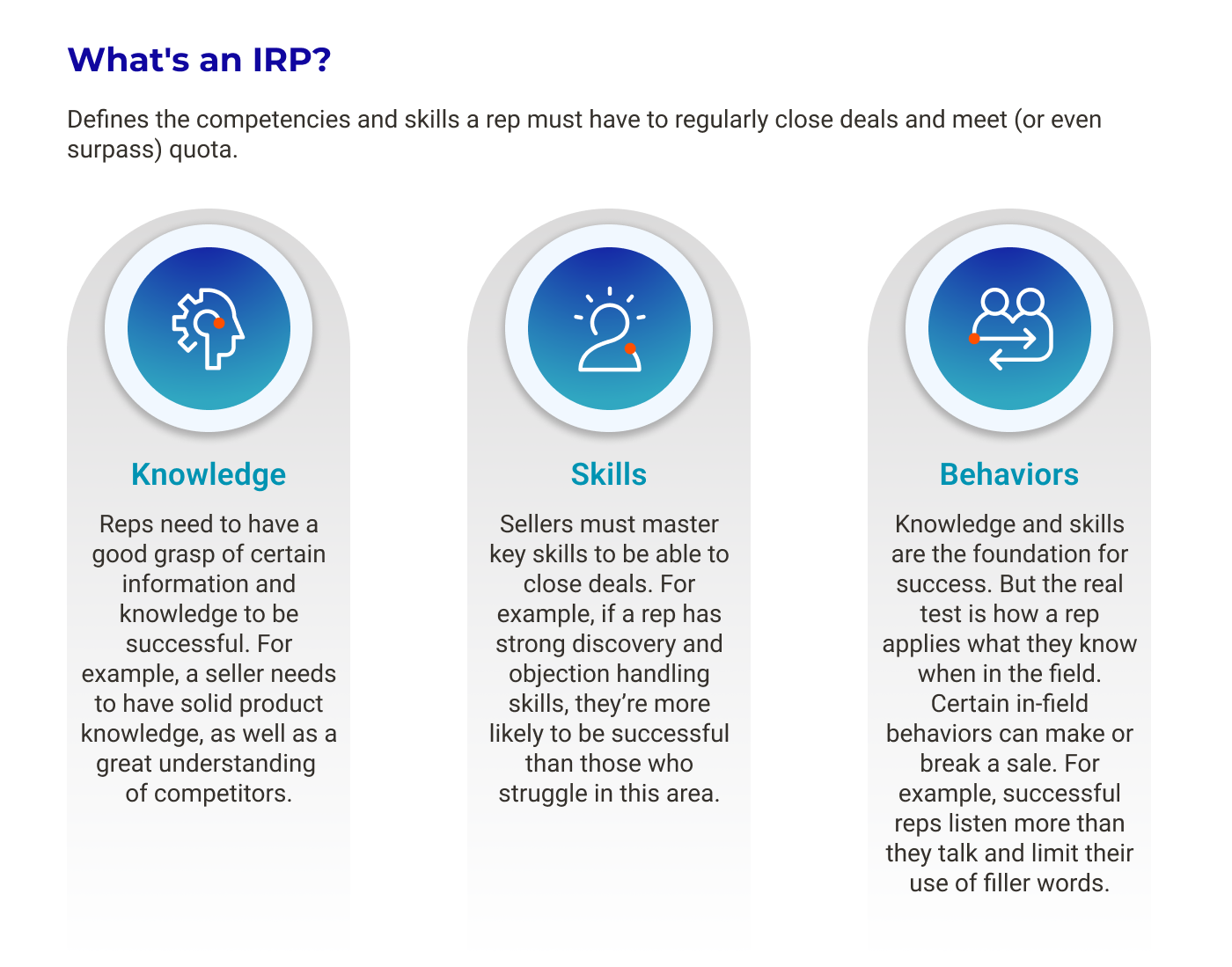Every closed deal requires two parts: the right buyer and the right seller.
The right buyer is one who’s the ideal fit for your solutions. The right seller is one who has what it takes to guide the deal through the sales cycle and eventually, across the finish line.
If one side of the equation isn’t quite right, there’s no deal.

The vast majority of organizations have the first half of the equation down pat. We ran a survey of more than 900 sales organizations and found that 93% have spent the time identifying and documenting their ideal customer profile (ICP), which outlines the key qualities that make a buyer a great fit for a seller’s solutions. This helps sellers understand where to focus their limited time and energy.
But all too often, organizations fail to pin down the second half of the equation: the seller. Less than 1% of sales orgs have developed a corresponding ideal rep profile (IRP) to document the knowledge, skills, and behaviors a seller needs to be successful.
That’s a big problem. It’s nearly impossible for an organization to create a team of great sellers when they’re not even sure what “great” looks like.
The best sales orgs know that the IRP lays the foundation for any readiness program. Those who take the time to create theirs are better positioned to deliver training and coaching that ensures all sellers are always ready to close any deal.
What is an ideal rep profile (IRP)?
Much like an ICP documents the key qualities of a good-fit prospect, an IRP defines the top competencies a seller must have to be successful in the field.
The competencies included in an IRP aren’t simply a laundry list of what sales leaders think reps need to be successful. Rather, they’re the competencies possessed by the best sellers – and those correlated with positive sales outcomes.
Think of it as figuring out the formula for a great seller – and then using that formula to create great reps over and over again.
The competencies in an IRP include a combination of:
- Knowledge: Reps need to have a good grasp of certain information and knowledge to be successful. For example, a seller needs to have solid product knowledge, as well as a great understanding of competitors.
- Skills: Sellers must master key skills to be able to close deals. For example, if a rep has strong discovery and objection handling skills, they’re more likely to be successful than those who struggle in this area.
- Behaviors: Knowledge and skills are the foundation for success. But the real test is how a rep applies what they know when in the field. Certain in-field behaviors can make or break a sale. For example, successful reps listen more than they talk and limit their use of filler words.

Why an ideal rep profile is the foundation of sales readiness
Many sales leaders still buy into the 80/20 philosophy — the belief that 20% of reps will always drive 80% of sales. They believe that sales is an art and that a seller either has what it takes or they don’t.
Sure, these organizations probably have onboarding to get new sellers up to speed. They may even deliver some continuous training and coaching.
But oftentimes, these programs are generic and one-size-fits-all. Everyone is expected to check off the same boxes regardless of their existing skills. And the key measure of success (or failure) is whether or not everyone has done so. The result of this approach is that the same great reps continue to hit their targets every time — while the vast majority of the others consistently miss theirs.
However, the best sales orgs know that sales is a science — and that sellers can be taught. It all starts with defining excellence.
Read: How To Manage A Sales Team: 12 Expert Tips For Success
Winning sales orgs understand that the IRP is the foundation of any successful sales enablement program. They take the time to document theirs — and then make it a point to continuously measure reps against this gold standard. This enables them to identify each rep’s strengths and gaps. That way, sales managers and enablement teams can deliver personalized training and coaching to close these gaps and get sellers closer to that gold standard.
How to create an ideal rep profile: 3-step framework
There’s no single IRP that works across the board. Instead, the formula for the idea rep varies based on role and organization.
Here’s a framework for creating an IRP that works for any organization.
Determine IRP roles
The competencies required for success vary based on the role of the individual. For example, while discovery skills are very important for an account executive, they’re less important for customer success teams. As such, it’s a best practice to create a separate IRP for each key role.
The first step is to determine the roles for which you’ll create IRPs. Typically, companies define IRPs for their go-to-market (GTM) or customer-facing roles. Our recent analysis of activity from more than 350 companies found that these are the top five roles for which organizations define their IRP:
- Account executives
- Business development representatives
- Channel sales
- Customer success
- Sales engineers
Identify goals and competencies
After identifying key roles, the next step is to identify the goals for each.
For example, a goal for a sales engineer is to perform structured demos, while one for a customer success manager might be to minimize churn.
Then, it’s time to determine the required competencies for each role. These should be the knowledge, skills, and behaviors each role needs to have to meet their goals.
This list shouldn’t be created based on gut feeling. Instead, it should be a list of competencies possessed by the best sellers. And each competency should be correlated with sales success.
How many competencies should be included in each IRP? Our analysis found that on average, organizations with an IRP define 15 competencies per role.
Rank key competencies
The typical IRP includes several competencies that are necessary for sales success. However, some carry more weight than others. After identifying the knowledge, skills, and behaviors for each role, it’s important to assign a rank to each.
How to leverage the IRP to create a team of quota crushers
Of course, simply creating an IRP doesn’t guarantee better sales results across the team. However, it should serve as the north star of the organization’s sales readiness program.
Once there’s alignment on the knowledge, skills, and behaviors necessary for sales success, sales and enablement leaders can work to develop onboarding, training, and content programs that focus on these key areas.
In addition, organizations must measure each rep’s competencies against the IRP on a regular basis. Completion of training modules and performance on assessments and quizzes matters.
But organizations must dig deeper to measure how their reps are actually putting their knowledge and skills into practice in the field. Gaining this intel might involve sitting in a rep’s call or leveraging conversation intelligence to see where reps are shining — and where things are going south.
By regularly measuring reps against the IRP, organizations can identify competency gaps early on. This allows managers to deliver targeted, personalized training and coaching to close these gaps. Then, they can measure improvement on key competencies — and how these improvements are impacting sales outcomes.
Busting the 80/20 myth starts with the IRP
Defining your ideal customer profile is important. But so too is establishing an IRP for the key roles on your customer-facing teams. Both sides of the equation must be just right for a deal to cross the finish line.
By establishing an IRP, you can finally bust the 80/20 myth and start building an entire team of reps who have what it takes to be successful. If you’d like to see what an ideal rep profile looks like for your revenue organization, head on over to Mindtickle’s IRP Generator and build one today.
 Edited by Kendra Fortmeyer @ Sales Hacker 2022
Edited by Kendra Fortmeyer @ Sales Hacker 2022







